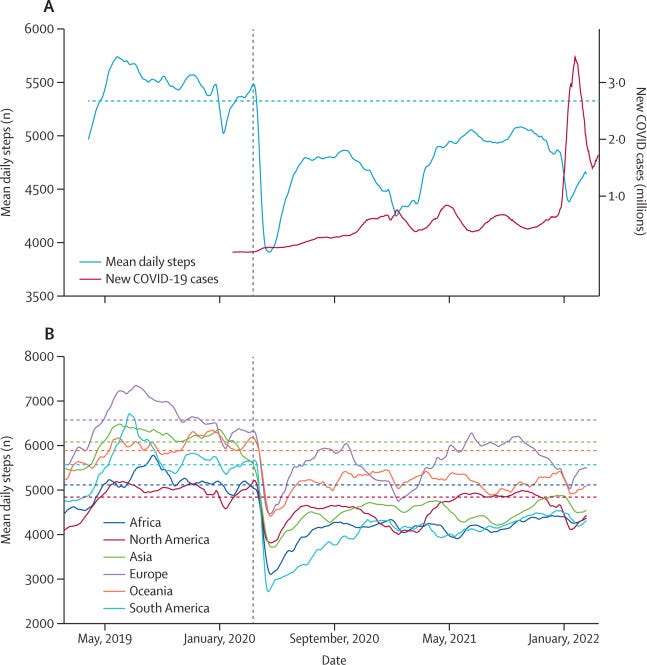Worldwide, physical activity has somewhat recovered but remains depressed compared with the pre-pandemic baseline
The Lancet — Global Health
Geoffrey H Tison, Joshua Barrios, Robert Avram, Peter Kuhar, Bojan Bostjancic, Gregory M Marcus, Mark J Pletcher, Jeffrey E Olgin
August 31, 2022
Executive Summary by:
Joaquim Cardoso MSc.
Health Transformation Movement
Physical Health Institute
September 5, 2022 (acsm)
What is the context:
- The COVID-19 pandemic has disrupted nearly all aspects of daily life worldwide.
- Public health interventions necessary to curb disease spread could have unintended consequences that adversely influence long-term health outcomes beyond near-term mortality.
- For example, step counts-a proxy for physical activity-were markedly lower early in the COVID-19 pandemic than pre-pandemic.
What are the findings of the study?
- Worldwide step counts have not returned to pre-pandemic levels in the 2 years since COVID-19 began.
- Step counts in Europe and North America appear to have recovered the most, but as of early 2022, they remain significantly lower than their pre-pandemic baseline.
- Patterns of step count recovery appear to reflect regional differences in the timing of COVID-19 infection surges, and might also correlate with changes in regional social distancing policies.
- The pace of recovery in physical activity might also reflect availability and uptake of COVID-19 vaccines, which varies by region.
ORIGINAL PUBLICATION (full version)

The COVID-19 pandemic has disrupted nearly all aspects of daily life worldwide.
Public health interventions necessary to curb disease spread could have unintended consequences that adversely influence long-term health outcomes beyond near-term mortality.
For example, step counts-a proxy for physical activity-were markedly lower early in the COVID-19 pandemic than pre-pandemic.
Public health interventions necessary to curb disease spread could have unintended consequences that adversely influence long-term health outcomes beyond near-term mortality.
For example, step counts-a proxy for physical activity-were markedly lower early in the COVID-19 pandemic than pre-pandemic.
As the global pandemic persists despite vaccines, understanding its long-term ramifications on physical activity-an important determinant of health -is crucial, and might help to inform public health and regional policy decisions.
We examined worldwide trends in physical activity, measured by step counts, 2 years since the onset of the COVID-19 pandemic.
As the global pandemic persists despite vaccines, understanding its long-term ramifications on physical activity-an important determinant of health -is crucial, and might help to inform public health and regional policy decisions
We hypothesised that worldwide physical activity remains lower than pre-COVID-19.
We used deidentified individual-level data from Jan 1, 2019, to Feb 17, 2022, collected from the freely available Azumio Argus smartphone app, a popular health-wellness app.
Daily step counts are determined using smartphone accelerometers and Apple or Android algorithms for step counting.
User location was determined by smartphone IP address. Pre-pandemic baseline mean steps were calculated per region using data from Jan 1, 2019, to Dec 31, 2019.
COVID-19 regional case counts were obtained from publicly available sources.
Significant differences in mean step counts for various time windows were examined using the Kruskal-Wallis and Conover’s tests with Bonferroni correction at p<0·001.
This study was reviewed and exempted by the University of California, San Francisco Institutional Review Board (20–30 539).

A total of 140 424 429 daily step count measurements were provided by 1 255 811 unique users from more than 200 countries and territories during the study period; 92% of smartphones were iOS, 8% were Android.
Worldwide, physical activity has somewhat recovered but remains depressed compared with the pre-pandemic baseline of 5323 steps per day during the 2019 calendar year ( figure).
Worldwide, physical activity has somewhat recovered but remains depressed compared with the pre-pandemic baseline of 5323 steps per day during the 2019 calendar year ( figure).

The mean step count in the 90 days preceding the end of the study period (November 2021-February 2022) was significantly lower for all continents compared with the same 90-day, 2019–2020 pre-pandemic period (p<0·001).
The same 2020–2021 mid-pandemic 90-day period was also significantly lower for all continents compared with the pre-pandemic period (p<0·001).
May to November, 2021 exhibited the greatest global recovery of step counts (4997 steps per day) since the start of the COVID-19 pandemic, although step counts remained 10% lower than the global pre-pandemic baseline (May to November, 2019; 5574 steps per day), with regional variation.
Compared with 2019, step counts recovered during May to November, 2021 the most in North America (4% lower than baseline) and Europe (14% lower than baseline), and the least in South America (29% lower than baseline) and Asia (30% lower than baseline; figure).
In the USA, step counts recovered between May and November, 2021 to 97% of the pre-pandemic May-November baseline ( appendix p 2), although the USA had relatively lower pre-pandemic step counts.
In all continents, the step count low point during the COVID-19 surge of January, 2022 was less severe than that during January, 2021.
Compared with the same mid-pandemic 2020–2021 period, mean step counts in the 90 days preceding the end of the study period (November 2021-February 2022) were significantly higher in North America and Europe-suggesting recovery-and significantly lower in Asia (p<0·001).
There were no significant differences in Africa, Oceania, and South America.
Regional differences in patterns of COVID-19 surges and step count decreases were observed.
For example, when examining trends in four countries and territories (arbitrarily chosen to describe intraregional heterogeneity), New Zealand, Taiwan, and Brazil exhibited COVID-19 surge patterns that greatly differed from those in the USA, and corresponded to regionally distinct step count patterns ( appendix p 2).
For example, when examining trends in four countries and territories (arbitrarily chosen to describe intraregional heterogeneity), …
New Zealand, Taiwan, and Brazil exhibited COVID-19 surge patterns that greatly differed from those in the USA, and corresponded to regionally distinct step count patterns

Conclusion
In summary, worldwide step counts have not returned to pre-pandemic levels in the 2 years since COVID-19 began. Step counts in Europe and North America appear to have recovered the most, but as of early 2022, they remain significantly lower than their pre-pandemic baseline. Patterns of step count recovery appear to reflect regional differences in the timing of COVID-19 infection surges, and might also correlate with changes in regional social distancing policies. The pace of recovery in physical activity might also reflect availability and uptake of COVID-19 vaccines, which varies by region.
Limitations
A primary limitation of our dataset is possible variability in user composition and app use patterns over time, which might reduce comparability of data across the study period.
There might also be measurement error from smartphone-measured step counts, and sampling bias due to reliance on smartphone app ownership and predominance of iOS, which might bias toward higher socioeconomic users or users from particular regions.
We did not have access to participant characteristics to adjust for socioeconomic differences.
Given the limitations in our available data and study approach, these results require validation in future studies using less biased data sources.
References & additional information
See the original publication
Originally published at https://www.thelancet.com.
About the authors & affiliations
Geoffrey H Tison,
Joshua Barrios,
Robert Avram,
Peter Kuhar,
Bojan Bostjancic,
Gregory M Marcus,
Mark J Pletcher,
Jeffrey E Olgin
Division of Cardiology, Department of Medicine,
University of California, San Francisco, CA 94143, USA (GHT, JB, RA, GMM, JEO);
Bakar Computational Health Sciences Institute, University of California, San Francisco, CA, USA (GHT); Azumio, Redwood City, CA, USA (PK, BB);
Department of Epidemiology and Biostatistics, University of California, San Francisco, CA, USA (MJP)












